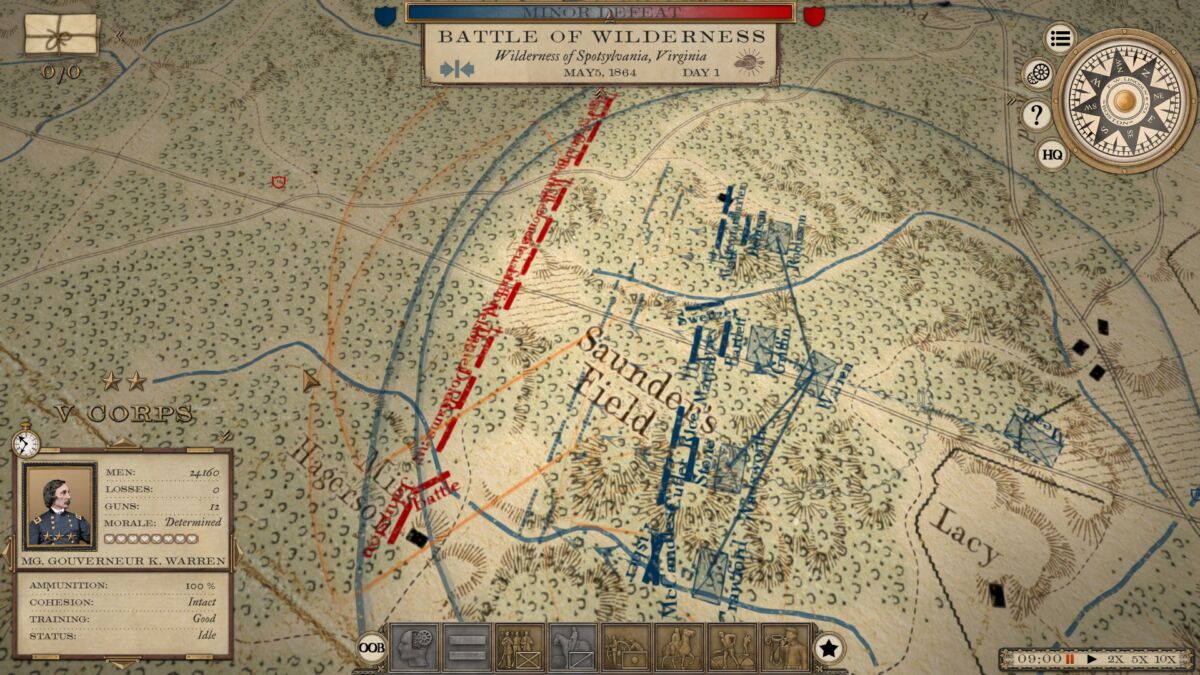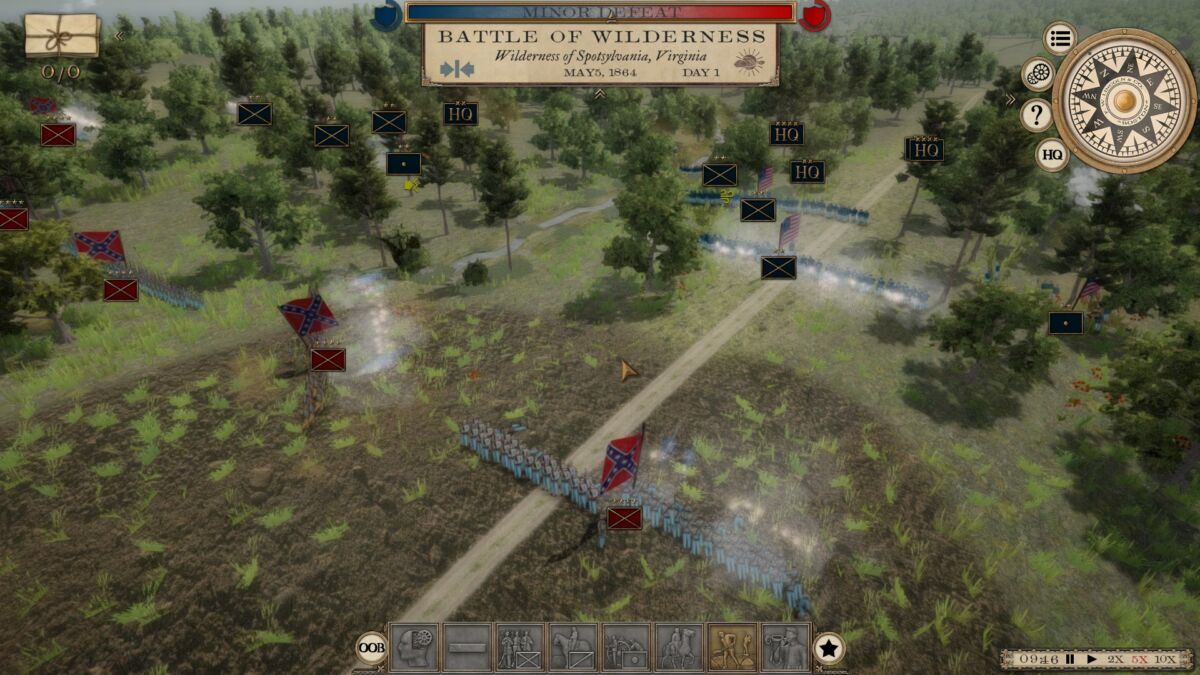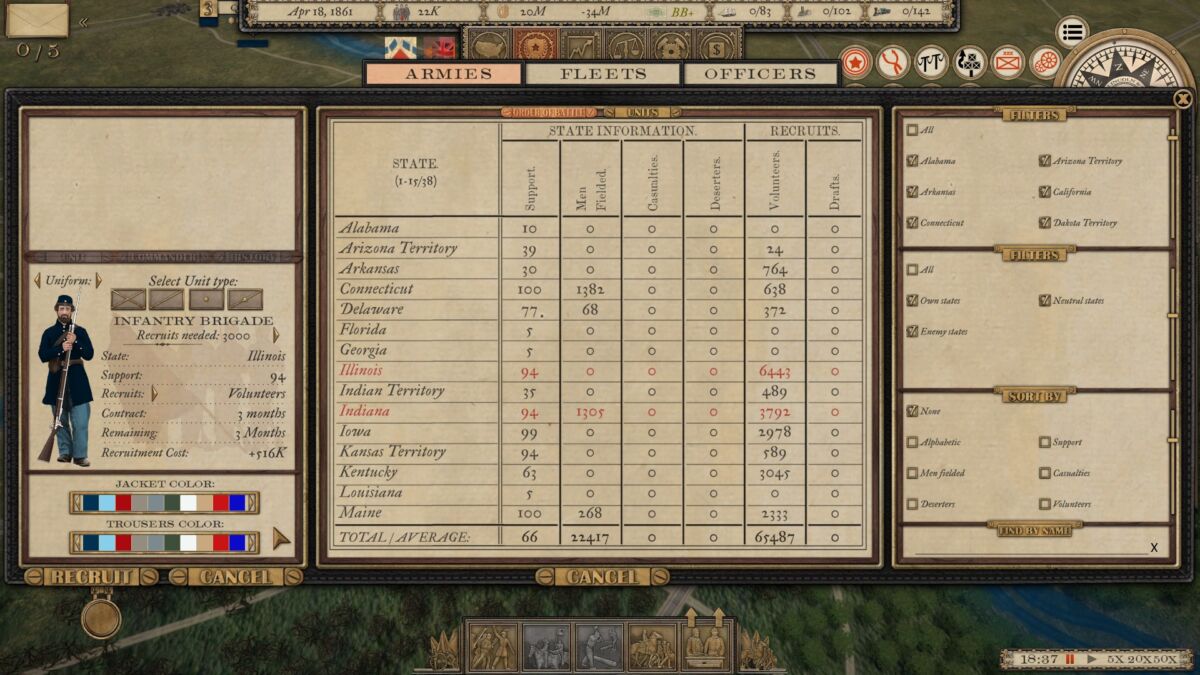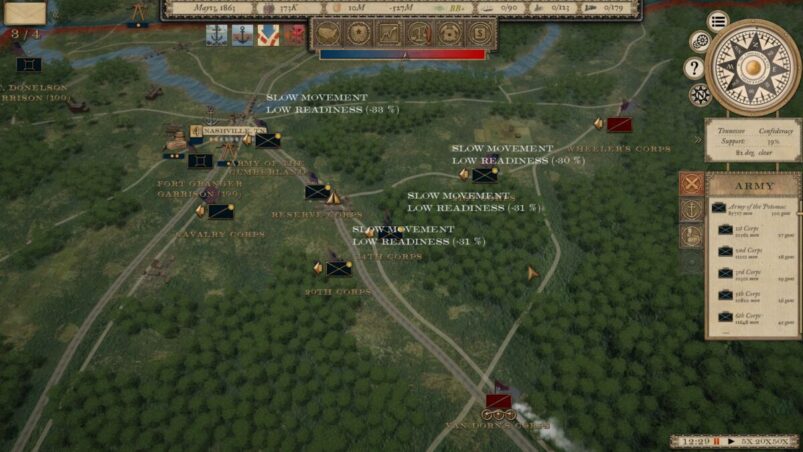Grand Tactician: The Civil War (1861-65) is a hardcore wargame through and through, covering the US Civil War where players play as either the Union or the Confederates with the goal of breaking the national spirit of their opposite and win the war. There are many complex systems at play in the game and it’s easy to get overwhelmed by what’s immediately available. To help players ease into this behemoth of a wargame, we drew up some helpful Grand Tactician: Civil War (1861-65) tips, strategies, and tactics to get you centered.
Pursue One Objective at a Time
Grand Tactician’s overall objective is simple – break the opponent’s national support for the war. However, this objective is too wide and gives little direction as to how to go about completing this mammoth task.
In the Strategy panel players will find a list of suggested smaller objectives that will eventually lead them to their victory. Pursuing one of these objectives at a time, for example taking back West Virginia from the CSA as the Union, is a good way of focusing military and economic efforts, as well as getting into the flow of the game.
Don’t Enact More Than One Policy

Throughout the game, players will be enacting policies, which will determine what resources the country will have access to. National cabinets have the option of enacting multiple policies at the same time, the cost of which is that the time to enact them goes way up. It’s far more efficient to enact one policy at a time to gain its benefit as soon as possible.
Manpower and Industrialization Are Key
Wars are won through logistical resilience and deep economic pockets. Manpower is needed to ensure that armies are at full strength and new units are raised to continuously keep up the pressure on the opponent. Industrialization for both the USA and CSA are vital as it not only improves domestic weapon production and unlocks new military technology, it also allows for government subsidies in the industrial sector, which leads to the foundation of new private businesses, improving the economy in the long-run.
Diplomacy is a Supplement to Industrialization

Diplomacy is another path for getting new weapons imported from the European major powers. You might be tempted to go down this line as it almost looks like an alternative to improving your own military industry. Players will never be able to match import numbers from diplomacy policies with domestic industrialization policies, especially since trade routes are susceptible to blockades.
Don’t Worry Too Much About Finances
The economy of both countries during the Civil War was based on a debt system, where governments would borrow money from various creditors to invest in the country. Players will notice that as they start spending more due to recruitment, construction, and subsidies their credit rating will stop dropping, which may cause some reservation towards spending.
Players should really only worry if their credit rating reaches a single B and even then one way of countering lower credit ratings is to temporarily enact funding policies.
Use the Auto-Recruit Feature

Players will spend a lot of time recruiting and managing their armies across their land. As army sizes swell, it will become quite difficult and tedious to keep recruiting single brigades at a time.
When recruiting new units, players are recommended to use the auto-recruit panel in the bottom left of the army screen, where they can set the number and size of the units they wish. This will drastically reduce time spent on tedious management.
Armies Should Support Each Other
Battles in Grand Tactician can be big bloody affairs where any advantage could mean the difference between repulsing and pursuing the enemy or transitioning to another day of tough fighting. One of the easiest ways to gain advantage is to bring in reinforcements from nearby armies and corps.
If positioned well, they can come from unexpected angles that may open up new tactical fronts from where to press the enemy. When maneuvering, it’s wise to make sure that armies and corps maneuver within the support range of each other, as represented by the larger circle around the army.
Build and Upgrade Depots

A successful campaign rests on how well armies can maintain their supply lines and keep themselves stocked, fed, and ready for fight. Depots are the most critical constructible available to either side, and an ample number of them will be needed to feed the ever-growing armies. Don’t forget to upgrade depots by manually clicking on them when selected, as bigger depots will be able to hold more supplies.
Use Cavalry as Scouts
Gone are the days of massive dramatic cavalry charges designed to break the enemy morale, as by the Civil War cavalry took more of a support role. In particular, the speed of cavalry makes them excellent scouts, both on the strategic and tactical maps, as well as great at raiding and harassment. Because of this, cavalry can benefit from fanning out in front of their supporting infantry armies to sniff out where the enemy troops are positioned.
Focus on the Macro

Combat in Grand Tactician is a sluggish affair and with the inevitable size increase of armies, microing will become a hellish task. A good way to get used to the game’s combat dynamics is to see divisions and corps as the main maneuver units that push up against each other. In other words, it’s recommended to think, plan, and act with overall army geography and positioning in mind rather than focusing on the exact position of single brigades, though for smaller skirmishes there will be plenty of time for micromanagement.
Build Breastworks
The US Civil War is an interesting case study as it foreshadowed the advent of trench and fortification warfare of World War I. Because weapons during this period are quite deadly, all infantry units have been trained in constructing fortifications of various kinds.
Regardless of the player’s own policies and troop training, all infantry can raise hasty breastworks on the battlefield to give themselves at least some cover. Players can do this even once battle starts, so when there’s a quiet moment with little action, get to digging those trenches.
Aim to Flank

Fighting battles to fully eliminate them is an impossible affair, as troops will more often breakaway, retreat, and flee from a fight they can’t win. Having two lines of infantry facing off in a long-range fire duel is an incredibly slow and grindy way of driving the enemy from the field. The best way to get things going in your favor is to find ways to flank enemy troops, be it locally with skirmishers or brigades of infantry or on a grander scale with entire divisions and corps, which put additional pressure from unexpected directions and often lead to victory.
Grand Tactician: Civil War (1861-65) is available on PC.
READ NEXT: 15 Best Switch Strategy Games
Some of the coverage you find on Cultured Vultures contains affiliate links, which provide us with small commissions based on purchases made from visiting our site. We cover gaming news, movie reviews, wrestling and much more.



